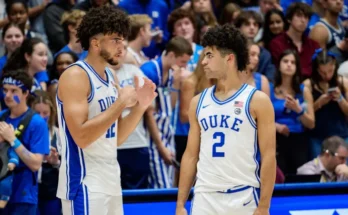The Big 12’s Bold Move: How They Challenged Greg Sankey’s Authority and Sparked a Conference Power Struggle
In the ever-evolving landscape of college athletics, power dynamics between conferences often shift, leading to strategic moves that can redefine the collegiate sports hierarchy. One such pivotal moment occurred when the Big 12 Conference made a bold move that seemed to challenge the authority and influence of Southeastern Conference (SEC) Commissioner Greg Sankey. This maneuver not only highlighted the Big 12’s ambition to assert its relevance but also ignited a broader conversation about the future of college sports and the balancing of power among conferences.
The catalyst for this power play was the Big 12’s decision to expand by adding four schools from the Pac-12: Arizona, Arizona State, Colorado, and Utah. This strategic expansion aimed to bolster the conference’s footprint and competitiveness, particularly in the wake of losing flagship programs like Texas and Oklahoma to the SEC. Big 12 Commissioner Brett Yormark was vocal about this expansion, emphasizing the conference’s newfound depth and national appeal. He boldly declared that the Big 12 would become “the deepest football conference in America,” a statement that was as ambitious as it was provocative.
In response to Yormark’s assertions, Commissioner Sankey took to social media to make a pointed comparison. He tweeted statistics showcasing the SEC’s superior social media following, highlighting that the SEC had over 2.5 million followers across all platforms, significantly outpacing the combined total of the Big 12’s new additions. While the tweet was framed as a factual observation, it was widely interpreted as a subtle jab at the Big 12’s claims of newfound prominence. Sankey’s message was clear: the SEC remained the dominant force in college athletics, and any attempts by other conferences to challenge that status would be met with scrutiny.
This exchange between the two commissioners underscored a deeper tension between the conferences. The SEC, under Sankey’s leadership, had long positioned itself as the premier conference in college sports, both in terms of on-field success and financial power. The addition of Texas and Oklahoma further solidified this position, bringing in two of the most storied programs in college football history. In contrast, the Big 12, facing the departure of its two flagship programs, was striving to redefine itself and maintain its relevance in an increasingly competitive landscape.
Yormark’s aggressive expansion strategy was indicative of the Big 12’s desire to remain a significant player in college athletics. By adding schools from the Pac-12, the Big 12 not only expanded its geographic reach but also aimed to tap into new television markets, thereby increasing its media rights value. This move was seen as a direct challenge to the SEC’s dominance, signaling that the Big 12 was not content to be relegated to a secondary status.
The rivalry between Sankey and Yormark was further intensified by their differing visions for the future of college sports. Sankey had been a proponent of a more centralized approach to governance, often advocating for the SEC’s interests in national discussions about playoff expansion and governance structures. Yormark, on the other hand, was positioning the Big 12 as a more decentralized and innovative entity, willing to take risks and challenge the status quo.
This ideological divide came to a head during discussions about the College Football Playoff (CFP) expansion. Sankey had been pushing for a model that would favor conferences with strong football traditions, like the SEC. Yormark, however, argued for a more inclusive approach that would provide opportunities for a broader range of teams. Their opposing viewpoints reflected the larger struggle for influence and control over the future direction of college football.
The public nature of their disagreements only served to highlight the growing rivalry between the two conferences. Media outlets and fans alike were quick to pick sides, fueling the narrative of a power struggle between the SEC and the Big 12. This rivalry was not just about football; it was emblematic of the broader shifts occurring in college athletics, where traditional power structures were being challenged by new and ambitious players.
In the aftermath of these events, the Big 12’s bold move was seen by many as a statement of defiance against the SEC’s perceived hegemony. By challenging Sankey’s authority and asserting its own relevance, the Big 12 demonstrated that it was no longer content to be a passive participant in the collegiate sports landscape. This development marked a significant turning point, signaling that the balance of power among college conferences was no longer fixed and that new contenders were emerging to vie for dominance.
Looking ahead, the implications of this power struggle are far-reaching. The Big 12’s expansion strategy may serve as a blueprint for other conferences seeking to enhance their competitiveness and media value. Additionally, the tensions between Sankey and Yormark could influence future decisions regarding playoff expansion, governance reforms, and television contracts. As the landscape of college athletics continues to evolve, the dynamics between conferences like the SEC and Big 12 will play a crucial role in shaping the future of the sport.
In conclusion, the Big 12’s strategic expansion and the subsequent challenges to Greg Sankey’s authority highlighted the shifting power dynamics in college athletics. This bold move by the Big 12 not only redefined its position in the collegiate sports hierarchy but also sparked a broader conversation about the future direction of college sports. As conferences continue to navigate the complexities of media rights, governance, and competition, the rivalry between the SEC and Big 12 will undoubtedly remain a focal point in the ongoing evolution of college athletics.



